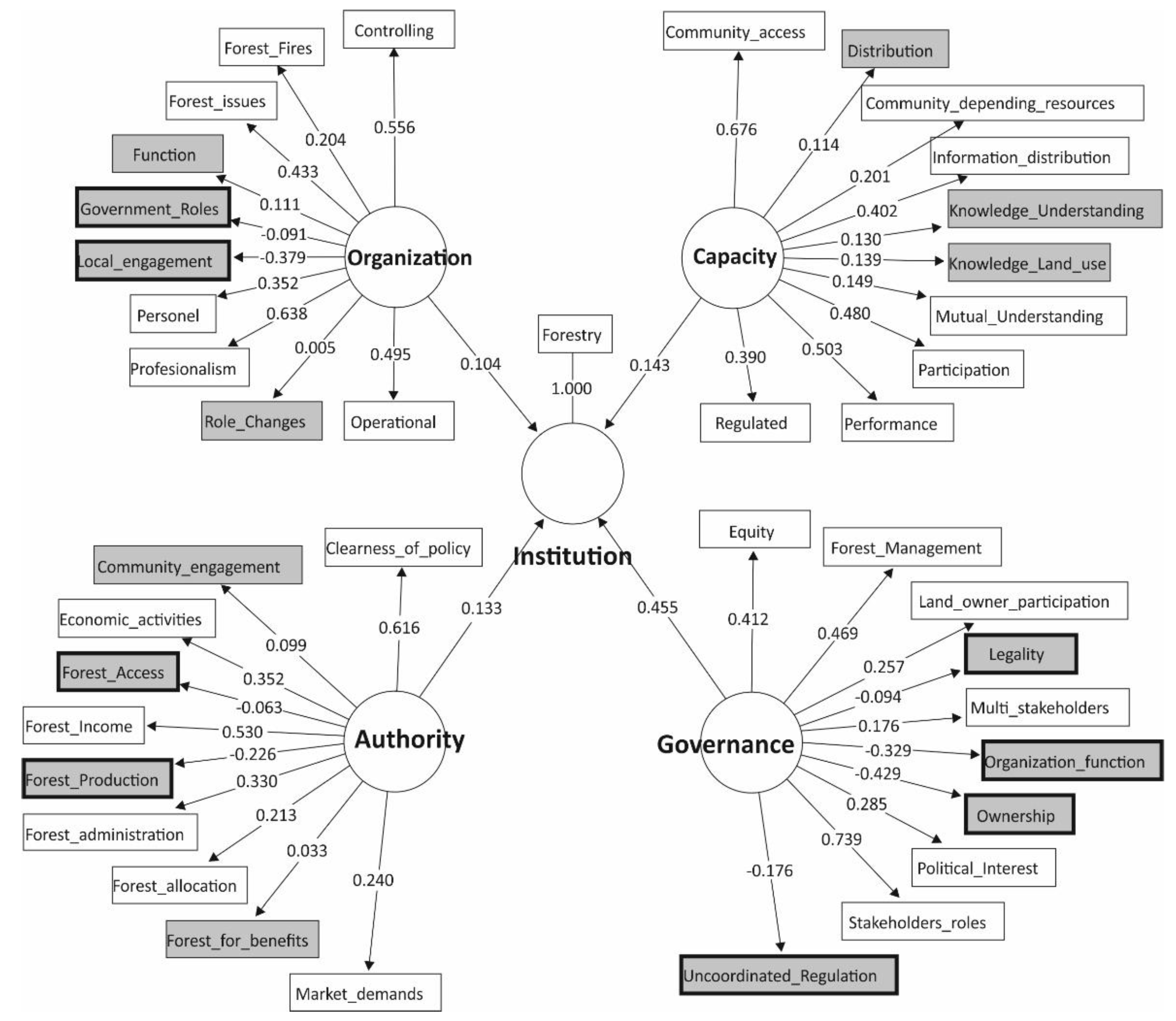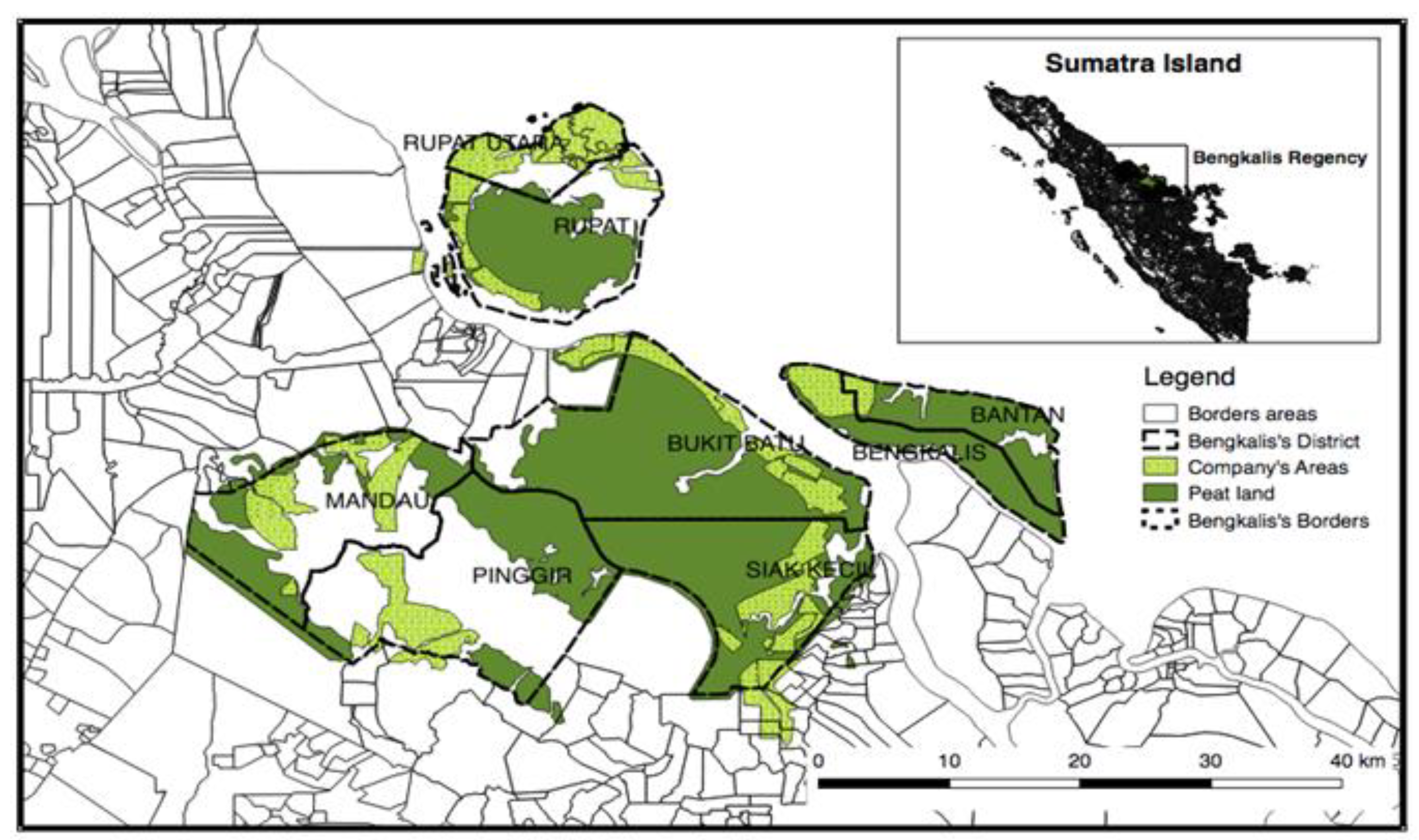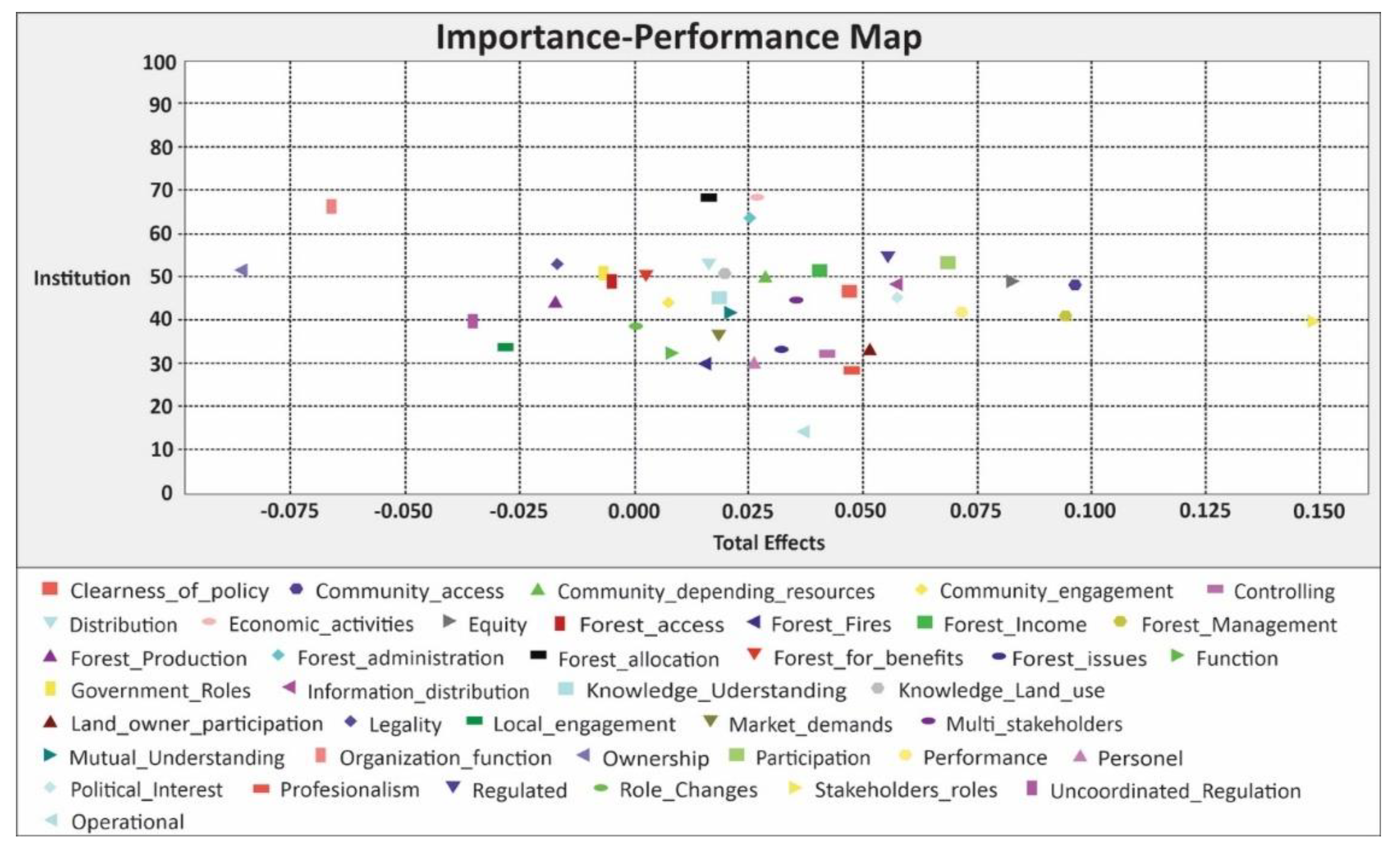Developing the Assessment and Indicators for Local Institutions in Dealing with Forest Fire Dilemmas
Abstract
1. Introduction
2. Literature Review
2.1. Institutional Approaches to Resources Management
2.2. Institutions and Agency of Resources Management
3. Materials and Methods
4. Results
5. Discussion
6. Conclusions
Author Contributions
Funding
Informed Consent Statement
Data Availability Statement
Acknowledgments
Conflicts of Interest
References
- Vasudeva, S.P. Disastrous Forest Fires: Management and Control. Indian J. Public Adm. 2018, 64, 237–253. [Google Scholar] [CrossRef]
- Miettinen, J.; Shi, C.; Liew, S.C. Two decades of destruction in Southeast Asia’s peat swamp forests. Front. Ecol. Environ. 2012, 10, 124–128. [Google Scholar] [CrossRef]
- Purnomo, E.P.; Anand, P.B.; Choi, J.-W. The complexity and consequences of the policy implementation dealing with sustainable ideas. J. Sustain. For. 2018, 37, 270–285. [Google Scholar] [CrossRef]
- Wolff, N.H.; Masuda, Y.J.; Meijaard, E.; Wells, J.A.; Game, E.T. Impacts of tropical deforestation on local temperature and human well-being perceptions. Glob. Environ. Chang. 2018, 52, 181–189. [Google Scholar] [CrossRef]
- Ramdani, R.; Lounela, A.K. Palm oil expansion in tropical peatland: Distrust between advocacy and service environmental NGOs. For. Policy Econ. 2020, 118, 102242. [Google Scholar] [CrossRef]
- Andersson, F.; Mårell, A.; Andersson, F.; Mårell, A. A European Network in Support of Sustainable Forest Management A European Network in Support of Sustainable Forest Management. J. Sustain. For. 2017, 24, 279–293. [Google Scholar] [CrossRef]
- Tiwari, P.C.; Joshi, B. Local and regional institutions and environmental governance in Hindu Kush Himalaya. Environ. Sci. 2015, 49, 66–74. [Google Scholar] [CrossRef]
- Andersson, K. Understanding decentralized forest governance: An application of the institutional analysis and development framework. Sustain. Sci. Pract. Policy 2017, 2, 25–35. [Google Scholar] [CrossRef]
- Moeliono, M.; Santoso, L.; Gallemore, C. REDD+ Policy Networks in Indonesia; Center for International Forestry Research (CIFOR): Borgor, Indonesia, 2013. [Google Scholar]
- Herawati, H.; Santoso, H. Tropical forest susceptibility to and risk of fire under changing climate: A review of fire nature, policy and institutions in Indonesia. For. Policy Econ. 2011, 13, 227–233. [Google Scholar] [CrossRef]
- Sahide, M.A.K.; Nurrochmat, D.R.; Giessen, L. The regime complex for tropical rainforest transformation: Analysing the relevance of multiple global and regional land use regimes in Indonesia. Land Use Policy 2015, 47, 408–425. [Google Scholar] [CrossRef]
- CNN Indonesia. BMKG Sebut Kebakaran Hutan Landa 11 Kabupaten di Riau; CNN Indonesia: Jakarta, Indonesia, 2019. [Google Scholar]
- North, D. Institutions, Institutional Change and Economic Performance (Political Economy of Institutions and Decisions); Cambridge University Press: New York, NY, USA, 1991. [Google Scholar]
- Ostrom, E. Governing the Commons: The Evolution of Institutions for Collective Action; Cambridge University Press: New York, NY, USA, 2015; ISBN 9781316423936. [Google Scholar]
- Hasan, M.A.; Nahiduzzaman, K.M.; Aldosary, A.S. Public participation in EIA: A comparative study of the projects run by government and non-governmental organizations. Environ. Impact Assess. Rev. 2018, 72, 12–24. [Google Scholar] [CrossRef]
- Hodgson, D. Conceptualising the compulsory education policy apparatus: Producing and reproducing risky subjectivities. J. Educ. Policy 2017, 0939, 1–16. [Google Scholar] [CrossRef]
- Charron, N.; Lapuente, V.; Annoni, P. Measuring quality of government in EU regions across space and time. Pap. Reg. Sci. 2019, 98, 1925–1953. [Google Scholar] [CrossRef]
- Alons, G. Environmental policy integration in the EU’s common agricultural policy: Greening or greenwashing? J. Eur. Public Policy 2017, 24, 1604–1622. [Google Scholar] [CrossRef]
- Agrawal, A.; Ostrom, E. Collective action, property rights, and decentralization in resource use in India and Nepal. Politics Soc. 2001, 29, 4. [Google Scholar] [CrossRef]
- Gibson, C.C.; Williams, J.T.; Ostrom, E. Local enforcement and better forests. World Dev. 2005, 33, 273–284. [Google Scholar] [CrossRef]
- Smith, J.; Obidzinski, K.; Subarudi, S.; Suramenggala, I. Illegal logging, collusive corruption and fragmented governments in Kalimantan, Indonesia. Int. For. Rev. 2003, 5, 293–302. [Google Scholar] [CrossRef]
- Cahill, C.; Sultana, F.; Pain, R. Participatory ethics: Politics, practices, institutions. ACME 2007, 6, 304–318. [Google Scholar]
- Li, Q.; Guan, X.; Wu, P.; Wang, X.; Zhou, L.; Tong, Y.; Ren, R.; Leung, K.S.M.; Lau, E.H.Y.; Wong, J.Y.; et al. Early Transmission Dynamics in Wuhan, China, of Novel Coronavirus-Infected Pneumonia. N. Engl. J. Med. 2020, 382, 1199–1207. [Google Scholar] [CrossRef]
- Agrawal, A. Common Property Institutions and Sustainable Governance of Resources. World Dev. 2001, 29, 1649–1672. [Google Scholar] [CrossRef]
- Purnomo, E.P.; Loilatu, M.J.; Nurmandi, A.; Salahudin; Qodir, Z.; Sihidi, I.T.; Lutfi, M. How Public Transportation Use Social Media Platform during Covid-19: Study on Jakarta Public Transportations’ Twitter Accounts? Webology 2021, 18, 1–19. [Google Scholar] [CrossRef]
- FAO State of the World’s Forests 2007-Africa. State World For. 2007, 5, 273–279.
- Agovino, M.; Garofalo, A.; Cerciello, M. Do local institutions affect labour market participation? The Italian case. BE J. Econ. Anal. Policy 2019, 19, 2. [Google Scholar] [CrossRef]
- Purnomo, E.P.; Ramdani, R.; Salsabila, L.; Choi, J.-W. Challenges of community-based forest management with local institutional differences between South Korea and Indonesia. Dev. Pract. 2020, 30, 1–12. [Google Scholar] [CrossRef]
- Brockhaus, M.; Obidzinski, K.; Dermawan, A.; Laumonier, Y.; Luttrell, C. An overview of forest and land allocation policies in Indonesia: Is the current framework sufficient to meet the needs of REDD+? For. Policy Econ. 2012, 18, 30–37. [Google Scholar] [CrossRef]
- Suhardi; Faridah, E.; Handojo, H.N. Rehabilitation of degraded forests in Indonesia. World Bank Tech. Pap. 2016, 270, 27–56. [Google Scholar]
- Nurmandi, A.; Purnomo, E.P. Making the Strategic Plan Work in Local Government: A Case Study of Strategic Plan Implementation in Yogyakarta Special Province (YSP). Int. Rev. Public Adm. 2011, 16, 143–164. [Google Scholar] [CrossRef]
- Anand, P.B. Right to information and local governance: An exploration. J. Hum. Dev. Capab. 2011, 12, 135–151. [Google Scholar] [CrossRef]
- Osei-Tutu, P.; Pregernig, M.; Pokorny, B. Interactions between formal and informal institutions in community, private and state forest contexts in Ghana. For. Policy Econ. 2015, 54, 1. [Google Scholar] [CrossRef]
- Mcallister, I. The Personalization of Politics. In The Oxford Handbook of Political Behavior; Oxford University Press: Oxford, UK, 2009; ISBN 9780191577178. [Google Scholar]
- Andersson, K. Local Governance of Forests and the Role of External Organizations: Some Ties Matter More Than Others. World Dev. 2013, 43, 226–237. [Google Scholar] [CrossRef]
- Tie, L.; Feng, M.; Huang, C.; Peñuelas, J.; Sardans, J.; Bai, W.; Han, D.; Wu, T.; Li, W. Soil Cover Improves Soil Quality in a Young Walnut Forest in the Sichuan Basin, China. Forests 2021, 12, 236. [Google Scholar] [CrossRef]
- Purnomo, E.P.; Zahra, A.A.; Malawani, A.D.; Anand, P. The Kalimantan Forest Fires: An Actor Analysis Based on Supreme Court Documents in Indonesia. Sustainability 2021, 13, 2342. [Google Scholar] [CrossRef]
- Hanna, S.; Folke, C.; Maler, K.G. Property rights and environmental resources. In Property Rights and the Environment: Social and Ecological Issues; The World Bank: Wahsingthon, DC, USA, 1995. [Google Scholar]
- Dewi, A.; Nurmandi, A.; Rochmawati, E.; Purnomo, E.P.; Dimas Rizqi, M.; Azzahra, A.; Benedictos, S.; Suardi, W.; Tri Kusuma Dewi, D. Global policy responses to the COVID-19 pandemic: Proportionate adaptation and policy experimentation: A study of country policy response variation to the COVID-19 pandemic. Health Promot. Perspect. 2020, 10, 359–365. [Google Scholar] [CrossRef] [PubMed]
- Gaveau, D.L.A.; Sloan, S.; Molidena, E.; Yaen, H.; Sheil, D.; Abram, N.K.; Ancrenaz, M.; Nasi, R.; Quinones, M.; Wielaard, N.; et al. Four decades of forest persistence, clearance and logging on Borneo. PLoS ONE 2014, 9, e101654. [Google Scholar] [CrossRef]
- Purnomo, E.P.; Ramdani, R.; Agustiyara; Tomaro, Q.P.V.; Samidjo, G.S. Land ownership transformation before and after forest fires in Indonesian palm oil plantation areas. J. Land Use Sci. 2019, 11, 1–15. [Google Scholar]
- Hair, J.F.; Sarstedt, M.; Hopkins, L.; Kuppelwieser, V.G. Partial least squares structural equation modeling (PLS-SEM): An emerging tool in business research. Eur. Bus. Rev. 2014, 26, 106–121. [Google Scholar] [CrossRef]
- Agustiyara; Purnomo, E.P.; Ramdani, R. Using Artificial Intelligence Technique in Estimating Fire Hotspots of Forest Fires. IOP Conf. Ser. Earth Environ. Sci. 2021, 717, 12019. [Google Scholar] [CrossRef]
- Tenenhaus, M. Component-based structural equation modelling. Total Qual. Manag. Bus. Excell. 2008, 19, 7. [Google Scholar] [CrossRef]
- Benitez, J.; Henseler, J.; Castillo, A.; Schuberth, F. Information & Management How to perform and report an impactful analysis using partial least squares: Guidelines for confirmatory and explanatory IS research. Inf. Manag. 2020, 57, 103168. [Google Scholar]
- Kim, Y.S.; Bae, J.S.; Fisher, L.A.; Latifah, S.; Afifi, M.; Lee, S.M.; Kim, I.A. Indonesia’s Forest Management Units: Effective intermediaries in REDD+ implementation? For. Policy Econ. 2016, 62, 69–77. [Google Scholar] [CrossRef]
- Jupesta, J.; Boer, R.; Parayil, G.; Harayama, Y.; Yarime, M.; De Oliveira, J.A.P.; Subramanian, S.M. Managing the transition to sustainability in an emerging economy: Evaluating green growth policies in Indonesia. Environ. Innov. Soc. Transit. 2011, 1, 187–191. [Google Scholar] [CrossRef]
- Koroso, N.H.; Zevenbergen, J.A.; Lengoiboni, M. Land institutions’ credibility: Analyzing the role of complementary institutions. Land Use Policy 2019, 81, 553–564. [Google Scholar] [CrossRef]
- Agovino, M.; Cerciello, M.; Ferraro, A.; Garofalo, A. Spatial analysis of wildfire incidence in the USA: The role of climatic spillovers. Environ. Dev. Sustain. 2021, 23, 6084–6105. [Google Scholar] [CrossRef]
- Falk, R.; Miller, N.B. A Primer for Soft Modeling. Open J. Bus. Manag. 2014, 21, 32–38. [Google Scholar]
- Zhang, J.; Liu, H.; Sayogo, D.S.; Picazo-Vela, S.; Luna-Reyes, L. Strengthening institutional-based trust for sustainable consumption: Lessons for smart disclosure. Gov. Inf. Q. 2016, 33, 552–561. [Google Scholar] [CrossRef]
- Kahsay, G.A.; Bulte, E. Trust, regulation and participatory forest management: Micro-level evidence on forest governance from Ethiopia. World Dev. 2019, 120, 118–132. [Google Scholar] [CrossRef]
- Ananda, J.; Proctor, W. Collaborative approaches to water management and planning: An institutional perspective. Ecol. Econ. 2013, 86, 97–106. [Google Scholar] [CrossRef]
- Yew, W.L.; Zhu, Z. Innovative autocrats? Environmental innovation in public participation in China and Malaysia. J. Environ. Manage. 2019, 234, 28–35. [Google Scholar] [CrossRef]
- Gustafsson, M.T.; Scurrah, M. Unpacking the extractivist state: The role of weak state agencies in promoting institutional change in Peru. Extr. Ind. Soc. 2019, 6, 206–214. [Google Scholar] [CrossRef]
- Dickinson, J.L.; Shirk, J.; Bonter, D.; Bonney, R.; Crain, R.L.; Martin, J.; Phillips, T.; Purcell, K. The current state of citizen science as a tool for ecological research and public engagement. Front. Ecol. Environ. 2012, 10, 291–297. [Google Scholar] [CrossRef]
- Song, A.M.; Temby, O.; Kim, D.; Saavedra, A.; Hickey, G.M. Measuring, mapping and quantifying the effects of trust and informal communication on transboundary collaboration in the Great Lakes fisheries policy network. Glob. Environ. Chang. 2019, 54, 6–18. [Google Scholar] [CrossRef]
- Ansell, C.; Gash, A. Collaborative Governance in Theory and Practice. JPART 2007, 18, 543–571. [Google Scholar] [CrossRef]
- Lockwood, M. Good governance for terrestrial protected areas: A framework, principles and performance outcomes. J. Environ. Manage. 2010, 91, 754–766. [Google Scholar] [CrossRef] [PubMed]
- Ostrom, E. Crossing the great divide. Co-production, synergy & development, polycentric governace and development. World Dev. 2009, 24, 1073–1087. [Google Scholar]
- FAO. The State of Food Insecurity in the World 2012; FAO: Rome, Italy, 2012; ISBN 9789251073162. [Google Scholar]
- Gbedomon, R.C.; Floquet, A.; Mongbo, R.; Salako, V.K.; Fandohan, A.B.; Assogbadjo, A.E.; Glèlè Kakayi, R. Socio-economic and ecological outcomes of community based forest management: A case study from Tobé-Kpobidon forest in Benin, Western Africa. For. Policy Econ. 2016, 64, 46–55. [Google Scholar] [CrossRef]
- Larson, A. Network Dyads in Entrepreneurial Settings: A Study of the Governance of Exchange Relationships. Adm. Sci. Q. 2006, 37, 76–104. [Google Scholar] [CrossRef]
- Sunderlin, W.D. Poverty alleviation through community forestry in Cambodia, Laos, and Vietnam: An assessment of the potential. For. Policy Econ. 2006, 8, 386–396. [Google Scholar] [CrossRef]




| Count | ||||||
|---|---|---|---|---|---|---|
| X2 | Total | |||||
| Chairs of Institutions | Members of Boards | Staff | Society | |||
| X1 | Province | 28 | 0 | 0 | 0 | 28 (35%) |
| Regency | 1 | 18 | 1 | 0 | 20 (23.8%) | |
| Villages (small-holders, fire care community (FCC)) | 0 | 0 | 20 | 2 | 22 (27.5%) | |
| NGOs | 0 | 0 | 0 | 11 | 11 (13.8%) | |
| Total | 29 (36.3%) | 18 (21.3%) | 21 (26.3%) | 13 (16.3%) | 81 (100%) | |
| Organization | Authority | Capacity | Governance | Institution | |
|---|---|---|---|---|---|
| Clearness_of_policy | 0.616 | ||||
| Community_access | 0.676 | ||||
| Community_depending_resources | 0.201 | ||||
| Community_engagement | 0.099 | ||||
| Controlling | 0.566 | ||||
| Distribution | 0.114 | ||||
| Economic_activities | 0.352 | ||||
| Equity | 0.412 | ||||
| Forest_access | −0.063 | ||||
| Forest_fires | 0.204 | ||||
| Forest_income | 0.530 | ||||
| Forest_management | 0.469 | ||||
| Forest_production | −0.226 | ||||
| Forest_administration | 0.330 | ||||
| Forest_allocation | 0.213 | ||||
| Forest_for_benefits | 0.033 | ||||
| Forest_issues | 0.433 | ||||
| Forestry | 1.000 | ||||
| Function | 0.111 | ||||
| Government_roles | −0.091 | ||||
| Information_distribution | 0.402 | ||||
| Knowledge_understanding | 0.130 | ||||
| Knowledge_land_use | 0.139 | ||||
| Land_owner_participation | 0.257 | ||||
| Legality | −0.084 | ||||
| Local_engagement | −0.379 | ||||
| Market_demands | 0.240 | ||||
| Multi_stakeholders | 0.176 | ||||
| Mutual_understanding | 0.149 | ||||
| Organization_function | −0.329 | ||||
| Ownership | −0.429 | ||||
| Participation | 0.480 | ||||
| Performance | 0.503 | ||||
| Personnel | 0.352 | ||||
| Political_interest | 0.285 | ||||
| Professionalism | 0.638 | ||||
| Regulated | 0.390 | ||||
| Role_changes | 0.005 | ||||
| Stakeholders_roles | 0.739 | ||||
| Uncoordinated_regulation | −0.176 | ||||
| Operational | 0.495 |
Publisher’s Note: MDPI stays neutral with regard to jurisdictional claims in published maps and institutional affiliations. |
© 2021 by the authors. Licensee MDPI, Basel, Switzerland. This article is an open access article distributed under the terms and conditions of the Creative Commons Attribution (CC BY) license (https://creativecommons.org/licenses/by/4.0/).
Share and Cite
Purnomo, E.P.; Agustiyara, A.; Ramdani, R.; Trisnawati, D.W.; Anand, P.B.; Fathani, A.T. Developing the Assessment and Indicators for Local Institutions in Dealing with Forest Fire Dilemmas. Forests 2021, 12, 704. https://doi.org/10.3390/f12060704
Purnomo EP, Agustiyara A, Ramdani R, Trisnawati DW, Anand PB, Fathani AT. Developing the Assessment and Indicators for Local Institutions in Dealing with Forest Fire Dilemmas. Forests. 2021; 12(6):704. https://doi.org/10.3390/f12060704
Chicago/Turabian StylePurnomo, Eko Priyo, Agustiyara Agustiyara, Rijal Ramdani, Dina Wahyu Trisnawati, P.B. Anand, and Aqil Teguh Fathani. 2021. "Developing the Assessment and Indicators for Local Institutions in Dealing with Forest Fire Dilemmas" Forests 12, no. 6: 704. https://doi.org/10.3390/f12060704
APA StylePurnomo, E. P., Agustiyara, A., Ramdani, R., Trisnawati, D. W., Anand, P. B., & Fathani, A. T. (2021). Developing the Assessment and Indicators for Local Institutions in Dealing with Forest Fire Dilemmas. Forests, 12(6), 704. https://doi.org/10.3390/f12060704








